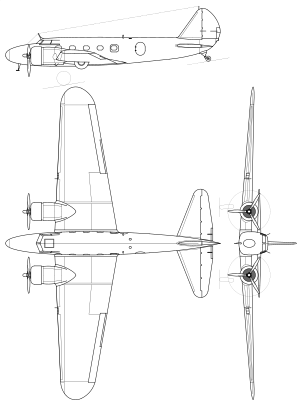Boeing 247
The Boeing Model 247 is an early American airliner, and one of the first such aircraft to incorporate advances such as all-metal (anodized aluminum) semimonocoque construction, a fully cantilevered wing, and retractable landing gear.
[6] Boeing introduced a host of aerodynamic and technical features into a new commercial airliner building on work with the earlier Monomail (Models 200, 221, 221A) mailplanes and B-9 bomber designs.
[13] Pratt & Whitney's chief engineer, George Mead, knew the problem would be resolved eventually,[11] but P&W's president, Frederick Rentschler acquiesced to the airline pilots' demand.
[17] Boeing incorporated design elements to enhance passenger comfort, such as the thermostat controlled, air conditioned, and noise-proofed cabin.
[20] The 247, race number "57", was essentially a production model, but all airliner furnishings were removed to accommodate eight additional fuselage fuel tanks.
[21] The MacRobertson Air Race attracted aircraft entries from all over the globe, including both prototypes and established production types, with the grueling course considered an excellent proving ground, as well as an opportunity to gain worldwide attention.
[21] The 247 was capable of crossing the United States from east to west eight hours faster than its predecessors, such as the Ford Trimotor and Curtiss Condor.
Entering service on May 22, 1933, a Boeing Air Transport 247 set a cross-country record of 19+1⁄2 hours on its San Francisco to New York City inaugural flight.
Boeing Air Transport bought 60 examples, United Aircraft Corp. 10, Lufthansa ordered three, but only two were delivered,[25][26] and one went to a private owner in China.
While the industry primarily standardized on Boeing's competitors, many of United's aircraft were later purchased by Western Air Express at "bargain-basement prices".
[30] A number of specially modified variants included a Boeing 247Y appropriated from United for Air Corps use as a test aircraft fitted with two machine guns in the nose.
[31] A 247D purchased by the British RAF became a testbed for instrument approach equipment and received a nonstandard nose, new powerplants, and fixed landing gear.











